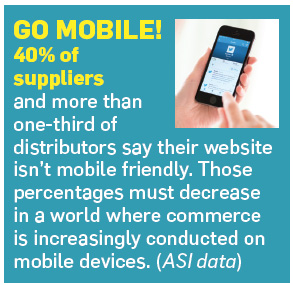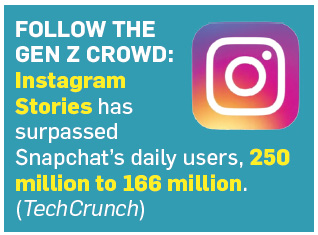November 29, 2017
18 Ways to Improve Your Business In 2018
A new year brings new opportunities for industry leaders to dominate the next 12 months.
It’s almost time to make your New Year’s Resolution.
While swearing off cookies and getting more exercise are always great choices, we suggest you also make pledges about growing your business in 2018. To get things rolling, Counselor is sharing 18 ways to boost your bottom line – all potentially actionable resolutions to keep next year. Whether it’s expanding on marketing efforts, improving operational efficiency or something else, the suggestions here will help stoke sales in the months ahead.
![]()
Optimize for Voice Search
Siri and Alexa have become the most popular voices since Morgan Freeman. Over half of U.S. teens and 41% of U.S. adults use voice search on a daily basis, according to a Google study conducted by Northstar Research. About 20% of all searches are conducted via voice, an amount expected to rapidly increase in 2018 and beyond. Research firm Gartner has gone so far as to predict that 30% of web browsing sessions will be conducted without a screen within the next three years.
Companies need to adapt to this growing search method by adjusting their SEO strategy. Voice-based queries are different than written searches, generally consisting of longer phrases and complete sentences. Websites should shift from including specific keywords about promotional products to answering commonly asked questions about the products or providing related instructional videos.

![]()
Get in on Virtual Reality
The hype is over – VR is here.
In October, Facebook announced its first all-in-one wireless VR headset, the Oculus Go. At $199, the device is affordable enough to be mainstream, providing users an immersive sensory-filled experience in the comfort of their homes. It also signifies a new medium in which marketers can promote their brand in innovative ways.
The promotional products industry has been eyeing VR since 2014, when Facebook invested $2 billion to buy Oculus, the maker of a VR headset device. Since then, Samsung, HTC and Sony have all joined the social media juggernaut as leaders in the VR marketplace.
VR will account for hardware revenue of up to $2.3 billion this year, according to International Data Corp. The total number of shipped headsets is expected to reach 9.6 million units this year, before skyrocketing to 110 million units by 2020.
Although suppliers are already offering brandable headsets and virtual reality glasses, the cutting-edge marketing opportunities are even greater. Before long, sales reps may be able to offer virtual reality catalogs and perform product demonstrations across the country and globe. Leveraging VR is an innovative strategy that will propel forward-thinking companies.
![]()
Consider Hiring “Boomerang” Employees
“Don’t burn your bridges” may be an old adage, but it’s timely advice in the 2018 workplace. More and more companies are re-hiring former employees who left on good terms for another opportunity. Nearly 76% of managers say they’re more accepting of hiring former employees than they were years ago, according to a Kronos and Workplace Trends study. It’s a trend especially prevalent among millennials, as 46% of Generation Y would consider returning to a former employer, while only 33% of Gen Xers and 29% of baby boomers would do the same. Thanks to social media, bosses are able to stay in touch with former workers, maintaining a professional relationship and leaving the door open for a future return. Re-hired employees could bring added experience and new connections while being familiar with the company culture.
![]()
Invest in AI
Artificial intelligence is rapidly entering society, changing the way many industries do business. More than 90% of companies in the energy, high tech, telecom, retail and automotive industries already use AI, according to Tata Consultancy Services. From marketing to finance to customer service, companies are relying on robotics and other forms of computerized machinery to achieve operational efficiency.
Gartner, an IT research and advisory firm, listed AI among the most strategic technology investments in 2018. Company executives hailed AI’s increasing ability to enhance decision-making, reinvent business models and improve customer experience. “Investment areas can include data preparation, integration, algorithm and training methodology selection, and model creation,” said David Cearley, vice president and Gartner Fellow, at the company’s symposium in October. “Multiple constituencies, including data scientists, developers and business process owners, will need to work together.”
The threat of AI-enhanced technology looms over the workforce, especially in the manufacturing industry. Between 2000 and 2010, 85% of manufacturing job losses in the U.S. were a result of automation, according to a study by the Center for Business and Economic Research at Ball State University. Technology and machines are replacing human beings as manufacturing output increases. More products are being made in a shorter amount of time with fewer people involved, and business owners are profiting.
Gartner execs believe it’s a necessary sacrifice for long-term gain: they estimate that AI will put 1.8 million people out of work by 2019, but will create 2.3 million jobs by 2020.
“If you look further out, we will soon enter a time of augmentation with AI where the best capabilities of humans are combined with the best capabilities of machine learning systems, not specifically automating people out of jobs, but in enhancing human capabilities by intelligent machines and software,” says Peter Sondergaard, executive vice president of research at Gartner.

![]()
Use Pulse Surveys
Annual reviews are becoming a thing of the past – pulse surveys are the future. Companies are realizing that checking in on employee engagement once a year or every six months is not enough. That’s why 19% of organizations are using short, informal, anonymous surveys monthly or even weekly, according to the CEB Corporate Leadership Council. The questions touch on happiness, work-life balance, future goals and other topics that don’t revolve around the company’s bottom line, at least on the surface. A recent Gallup poll shows that companies with high employee engagement see a 20% increase in productivity.
![]()
Target the Marijuana Market
The legal cannabis industry is lighting up after North American sales grew by an unprecedented 30% in 2016 to $6.7 billion, according to Arcview Market Research. With industry sales projected to top $20.2 billion by 2021, the time is now for distributors to target dispensaries across the eight states that have legalized recreational marijuana for adults.
Although advertising regulations vary from state to state, California had a major breakthrough this year as a proposed bill banning legally licensed cannabis companies from using branded merchandise was placed on hold, allowing promotional product firms to cash in – at least for the time being.
There is also potential opportunity north of the border – Canada is expected to legalize marijuana on a national level for consumption by people age 18 and older by the summer of 2018. While legislators are debating regulations, such as outlawing packaging, labeling and promotional products that appeal to youth, the market will still be ripe for persistent and innovative Canadian distributors.
![]()
Leverage Crowdfunding
In this age of radical transparency, companies are peeling back the curtain and allowing customers to see every step of the process, from product design to employee performance to tracking deliveries.
Indeed, crowdfunding has exploded over the past few years as websites like Kickstarter and GoFundMe have invited consumers to contribute financially toward projects they’d like to see developed. The World Bank projects that crowdfunding will blossom into a $96 billion industry by 2038, far surpassing the current venture capital industry.
Originally devised as a way for startups to raise capital, crowdfunding sites have also become a proving ground for established companies to validate new products before production.
Corporations like GE Appliances and Smith & Bradley Ltd. have used crowdfunding to introduce customers to product ideas, and then based on the majority’s reaction, either go forward or scrap the idea. Suppliers and distributors can use this outlet to learn from end-users, reducing the cost and risk of innovation, while speeding up time to market for supported products.
![]()
Enhance Service with Chatbots
Perhaps the most widespread application of AI, chatbots are computer programs designed to simulate conversation with human users and improve customer service efficiency. Instead of waiting on hold to reach a customer service rep, chatbots provide people with instant access to companies. Chatbots quickly interact with customers in a personal fashion, driving customer engagement by answering questions or offering suggestions. Their prevalence will only grow: By 2020, 85% of a customer relationship will be managed without human interaction, Microsoft has reported.
While chatbots are a costly investment, typically ranging from $30,000 to $250,000 depending on the capabilities built into it, companies are willing to pay. In fact, more than 80% of businesses say they want a chatbot by the end of 2020. Crunch the numbers, and if they make sense, don’t fall behind the curve when it comes to chatbots.
![]()
Go Forward With Gamification
As the average human attention span has fallen to eight seconds since 2000, keeping employees engaged in their work has become increasingly challenging. Many companies have turned to gaming to stimulate workers’ minds during training sessions and team meetings. It’s for far more than just fun: There’s a 17% higher retention rate in curriculum involving gaming over lectures, according to gamification analyst and Bloomsburg University professor Karl Kapp. Employees have something to strive for, earning points or rewards for completing tasks while digesting mundane information in an exciting manner.

![]()
Prepare for Drones
Amazon, Google, UPS, Walmart and even convenience store chain 7-Eleven have all joined the race to get delivery drones off the ground. Although the Federal Aviation Administration’s commercial drone rules still prevent a totally Jetsons world, companies are taking more steps toward a drone-filled future.
Amazon has filed for a patent for towers that would serve as multi-level fulfillment centers for its delivery drones. The facilities would be built vertically to blend in with city high-rises and include a self-service area where customers can pick up items. Walmart, taking a different approach, has been granted a patent for a system in which drones would shuttle products between different departments inside its stores.
While two major hurdles remain for companies planning on drone deliveries – they must stay in sight of an operator and can’t be flown over people – it’s clearly the next frontier in an industry shifting toward automation and instant delivery.
![]()
Follow & Utilize Micro-Influencers
Instead of celebrity endorsements, brands are opting to work with micro-influencers – individuals who work in a specific category or are seen as a trusted source. Brands are partnering with micro-influencers who spread desired messages to their dedicated followings – who are, of course, the brands’ desired audiences – on social media platforms. North Face, Hubspot and Rolex all leverage influencers to connect with new audiences and improve engagement with existing customers.
A study from the Wharton School and Keller Fay Group found that 82% of consumers surveyed reported that they were highly likely to follow a recommendation made by a micro-influencer. These influencers have up to 22.2 times more conversations each week regarding recommendations on what to buy versus an average consumer. The study says 94% of consumers surveyed believe micro-influencers are more credible and knowledgeable than average people. In terms of who’s better at explaining how the product works, 92% of responders voted for micro-influencers.
With a total audience size of between 1,000 and 100,000 followers, micro-influencers are four times more likely to get a comment on a post than are macro-influencers (who usually have 10 million followers or more), according to marketing agency Makerly. Brands can capitalize on this intimate connection already established between influencer and consumer, saving time, effort and money in the process.

![]()
Step Up Social Video Marketing
Facebook has been the bellwether for marketers, leading the rush toward investments in VR and video advertising. It’s no surprise, as nearly all of the company’s revenue comes from advertising, and marketers salivate over the platform’s 1 billion daily active users. Social video ad spending is expected to double this year to $4 billion, according to marketing consulting firm Magna, accounting for one-third of all U.S. digital ad spending in 2017. Next year, mobile video ad spend will grow 49% to roughly $18 billion, Recode reported.
In an effort to attract more ads, Facebook is looking to buy original content for 2018, The Wall Street Journal has said. That’s a golden opportunity for suppliers and distributors to create not only ads of their own, but also product tutorials, business tips and other types of video that Facebook could purchase and present.
Additionally, companies should focus on streaming live video, which Facebook says people watch three times longer than prerecorded video. It’s an effective strategy for driving engagement as Facebook Live videos fuel comments at over 10 times the rate of non-live video. Business leaders have already caught on to the trend: in June, company Facebook pages streamed nearly 200 live videos, six times more than the number of videos posted from company pages in January.

![]()
Comply With the General Data Protection Regulation
Starting May 25, 2018, the General Data Protection Regulation goes into effect. It’s a combined measure by the European government and authorities to strengthen data protection across the European Union. The legislation will unify data privacy laws across the continent and extend the scope of the regulation to all foreign companies processing data of EU residents. With 27% of suppliers currently operating in the European market, it’s crucial for North American industry companies to adhere to the regulation. If they don’t, they’ll face a maximum fine of €20 million or 4% of their annual global revenue.
Email: jcorrigan@asicentral.com